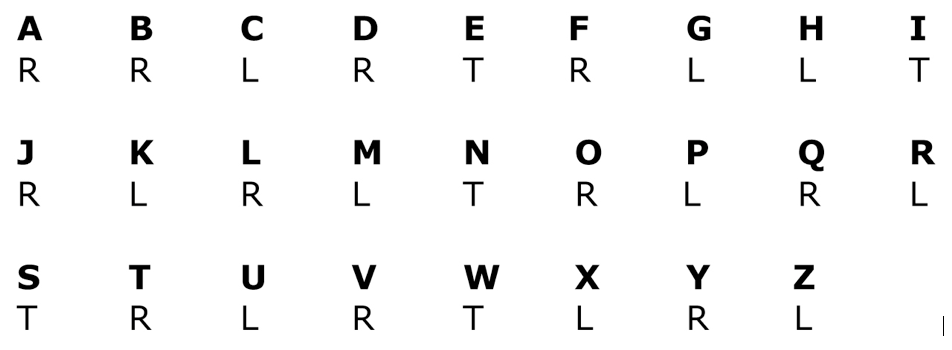Brain Gym
Any physical challenges similar to those below (rubbing your tummy while patting your head, etc) help wake you up by stimulating both hemispheres of the brain, but certain bilateral exercises, known as Brain Gym, have additional positive effects (by working on the body’s energy system). The ultimate bilateral brain gym exercise is juggling which helps with speed reading.
During breaks, challenge yourself by trying (and perfecting) one or more of the following Brain Gym fun exercises
Breaks are a very important part of speed reading and any learning. They help to relax, refocus and boost dopamine levels which is important for motivation and focus. Resting and exercising your eyes is also important for optimum speed reading.
Moving alphabet
Read the alphabet aloud as written on the chart. As you do so, raise your Right hand if the letter below is R, raise your Left hand if the letter below is L, and raise both hands Together if the letter below is T.
It’s harder than it looks, but if you can do it easily, then read the alphabet backwards – or read up and down the columns – or additionally lift your opposite knee (ie R = raise your right hand and left knee, L = raise your left hand and right knee, T = raise both hands and both legs/jump).
Cross crawl
Lift your left leg and touch your left knee with your right hand (arm crosses the body). Then lift your right leg and touch your right knee with your left hand. Keep going, touching alternate knees – as slowly as possible. (A more energetic variation is to touch elbows to the opposite knee.)
Cook’s hook ups
Put both hands out in front of you, backs of your hands together, thumbs facing down. Place one hand over the other so palms are facing, then interlace your fingers. Swivel your interlocked hands together towards you, and bring them up under your chin. Cross one leg over the other. Relax shoulders, tummy and face. Put the tip of your tongue on the roof of your mouth and take several deep breaths. This is a particularly calming and focusing exercise to end with before going back to work.
Juggling
Reseach suggests that juggling is one of the best (fun) ways to boost your brain power and learning. Learn more about the power of juggling and what it can do for your brain and learning

